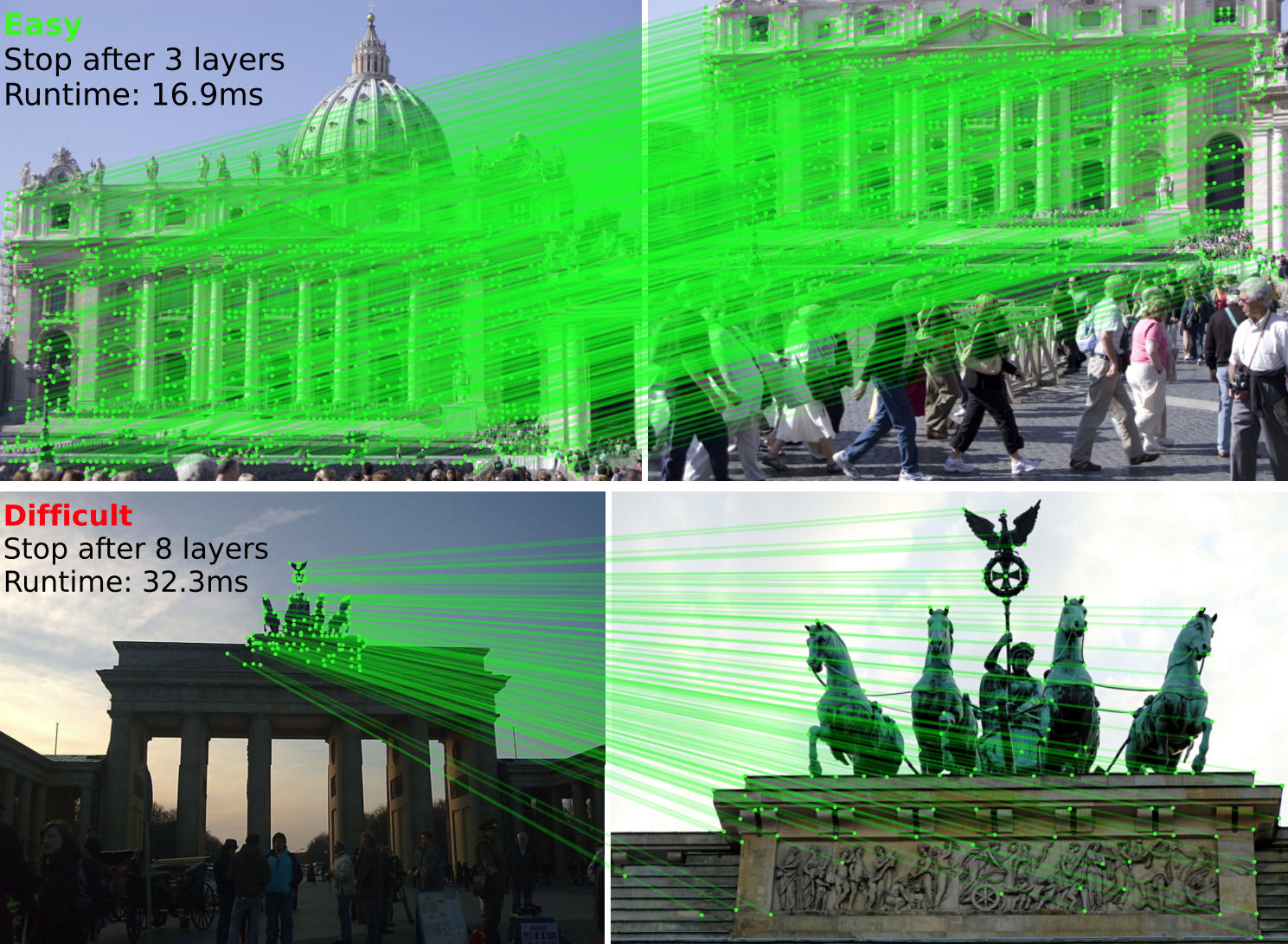LightGlue ONNX
Open Neural Network Exchange (ONNX) compatible implementation of LightGlue: Local Feature Matching at Light Speed. The ONNX model format allows for interoperability across different platforms with support for multiple execution providers, and removes Python-specific dependencies such as PyTorch.
ONNX Export
Prior to exporting the ONNX models, please install the requirements of the original LightGlue repository. (Flash Attention does not need to be installed.)
To convert the SuperPoint and LightGlue models to ONNX, run the following script:
python export_superpoint_lightglue.py --img_size 512 --superpoint_path weights/superpoint.onnx --lightglue_path weights/superpoint_lightglue.onnxAlthough dynamic axes have been specified, it is recommended to export your own ONNX model with the appropriate input image sizes of your use case.
ONNX Inference
With ONNX models in hand, one can perform inference on Python using ONNX Runtime (see requirements-onnx.txt).
The SuperPoint+LightGlue inference pipeline has been encapsulated into a runner class:
from onnx_runner import SuperpointLightglueRunner, load_image
img0_path = "assets/sacre_coeur1.jpg"
img1_path = "assets/sacre_coeur2.jpg"
size = 512
image0, scales0 = load_image(img0_path, resize=size)
image1, scales1 = load_image(img1_path, resize=size)
# Create ONNXRuntime runner
runner = SuperpointLightglueRunner(
superpoint_path="weights/superpoint.onnx",
lightglue_path="weights/superpoint_lightglue.onnx",
providers=["CUDAExecutionProvider", "CPUExecutionProvider"],
)
# Run inference
m_kpts0, m_kpts1 = runner.run(image0, image1, scales0, scales1)Caveats
As the ONNX Runtime does not support features like dynamic control flow, certain configurations of the models cannot be exported to ONNX easily. These caveats are outlined below.
Feature Extraction
- The
DISKextractor cannot be exported to ONNX due to the use ofsamepadding in the convolution layers of its UNet. - The
max_num_keypointsparameter (i.e., setting an upper bound on the number of keypoints returned by the extractor) is not supported at the moment due totorch.topk(). - RGB input images are assumed. Please convert grayscale images to RGB (e.g., by stacking thrice) first.
- Only batch size
1is currently supported.
LightGlue Keypoint Matching
- Since dynamic control flow is unsupported, by extension, early stopping and adaptive point pruning (the
depth_confidenceandwidth_confidenceparameters) are also difficult to export to ONNX. - PyTorch's
F.scaled_dot_product_attention()function fails to export to ONNX as of version2.0.1. However, this issue seems to be fixed in PyTorch-nightly. Currently, the backup implementation (elsebranch oflightglue_onnx.lightglue.FastAttention.forward) is used. - Mixed precision is turned off.
Additionally, the outputs of the ONNX models differ slightly from the original PyTorch models (by a small error on the magnitude of 1e-6 to 1e-5 for the scores/descriptors). Although the cause is still unclear, this could be due to differing implementations or modified dtypes.
Possible Future Work
- Support for TensorRT
- Support for dynamic control flow, larger batch sizes, etc.
Credits
If you use any ideas from the papers or code in this repo, please consider citing the authors of LightGlue and SuperPoint:
@inproceedings{lindenberger23lightglue,
author = {Philipp Lindenberger and
Paul-Edouard Sarlin and
Marc Pollefeys},
title = {{LightGlue}: Local Feature Matching at Light Speed},
booktitle = {ArXiv PrePrint},
year = {2023}
}@article{DBLP:journals/corr/abs-1712-07629,
author = {Daniel DeTone and
Tomasz Malisiewicz and
Andrew Rabinovich},
title = {SuperPoint: Self-Supervised Interest Point Detection and Description},
journal = {CoRR},
volume = {abs/1712.07629},
year = {2017},
url = {http://arxiv.org/abs/1712.07629},
eprinttype = {arXiv},
eprint = {1712.07629},
timestamp = {Mon, 13 Aug 2018 16:47:29 +0200},
biburl = {https://dblp.org/rec/journals/corr/abs-1712-07629.bib},
bibsource = {dblp computer science bibliography, https://dblp.org}
}